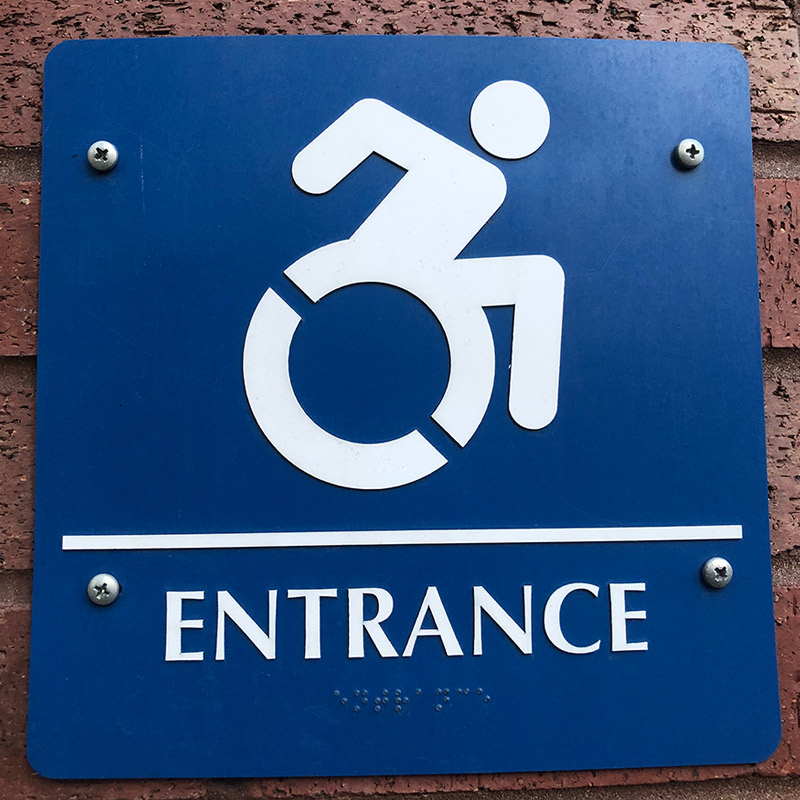The Benefits of Using High-Quality ADA Signs in Your Business
Exploring the Trick Features of ADA Indications for Boosted Access
In the world of accessibility, ADA indications offer as quiet yet effective allies, guaranteeing that spaces are inclusive and navigable for individuals with disabilities. By integrating Braille and tactile elements, these indications damage barriers for the visually damaged, while high-contrast shade schemes and readable fonts cater to varied aesthetic needs.
Relevance of ADA Conformity
Making sure conformity with the Americans with Disabilities Act (ADA) is important for cultivating inclusivity and equivalent accessibility in public areas and work environments. The ADA, established in 1990, mandates that all public centers, employers, and transport solutions accommodate individuals with impairments, guaranteeing they enjoy the same legal rights and possibilities as others. Compliance with ADA requirements not just meets lawful obligations yet also enhances an organization's track record by showing its dedication to diversity and inclusivity.
One of the crucial elements of ADA compliance is the execution of obtainable signage. ADA signs are designed to make certain that people with impairments can quickly browse with areas and structures.
Moreover, sticking to ADA policies can mitigate the threat of potential penalties and lawful repercussions. Organizations that fall short to follow ADA guidelines may deal with legal actions or charges, which can be both financially troublesome and harmful to their public picture. Hence, ADA compliance is indispensable to fostering a fair environment for everybody.
Braille and Tactile Components
The consolidation of Braille and responsive components right into ADA signage symbolizes the principles of access and inclusivity. It is typically placed under the equivalent message on signs to ensure that individuals can access the details without visual help.
Responsive elements prolong beyond Braille and include raised signs and characters. These components are designed to be noticeable by touch, allowing people to recognize area numbers, toilets, leaves, and other essential areas. The ADA sets particular guidelines regarding the size, spacing, and placement of these tactile components to enhance readability and make sure uniformity throughout various atmospheres.

High-Contrast Color Pattern
High-contrast color design play a pivotal function in improving the visibility and readability of ADA signs for individuals with aesthetic disabilities. These systems are necessary as they make best use of the difference in light reflectance in between text and history, ensuring that indicators are easily noticeable, even from a distance. The Americans with Disabilities Act (ADA) mandates the usage of details color contrasts to suit those with limited vision, making it a crucial facet of conformity.
The efficacy of high-contrast colors depends on their ability to stick out in different lighting conditions, consisting of dimly lit atmospheres and locations with glare. Commonly, dark text on a light history or light message on a dark background is used to accomplish optimal contrast. Black message on a yellow or white history offers a stark aesthetic distinction that aids in quick acknowledgment and understanding.

Legible Fonts and Text Dimension
When taking into consideration the design of ADA signage, the choice of readable fonts and proper message dimension can not be overemphasized. These components are crucial for guaranteeing that indications come to people with aesthetic problems. The Americans with Disabilities Act (ADA) mandates that typefaces must be sans-serif and not italic, oblique, script, highly decorative, or of unusual form. These needs assist ensure that the text is easily legible from a range which the personalities are appreciable to diverse audiences.
According to ADA standards, the minimal message elevation ought to be 5/8 inch, and it needs to boost proportionally with viewing range. Consistency in message dimension contributes to a cohesive visual experience, aiding individuals in browsing environments efficiently.
Moreover, spacing between lines and letters is important to readability. Ample spacing avoids personalities from showing up crowded, enhancing readability. By sticking to these requirements, developers can considerably boost accessibility, making sure that signs offers its designated function for all people, no matter their aesthetic capabilities.
Efficient Positioning Techniques
Strategic placement of ADA signage is vital for taking full advantage of ease of access and ensuring conformity with legal criteria. ADA guidelines specify that signs ought to be mounted at an elevation between 48 to 60 inches from the ground to ensure they are within the line of sight for both standing and seated people.
Additionally, indications have to be positioned surrounding to the lock side of doors to enable very easy identification prior to access. Uniformity in sign positioning throughout a center boosts predictability, minimizing confusion and boosting total customer experience.

Conclusion
ADA indicators play an important function in advertising access by incorporating features that attend to the demands of individuals with handicaps. Integrating Braille and responsive components guarantees important information is easily accessible to the visually impaired, while high-contrast color plans and understandable sans-serif fonts enhance exposure throughout numerous lighting conditions. Effective placement techniques, such as proper placing elevations and strategic locations, even more help with navigation. These aspects jointly cultivate a comprehensive setting, underscoring the importance of ADA conformity in ensuring browse this site equal access for all.
In the realm of ease of access, ADA indicators serve as silent yet powerful allies, making sure that rooms are inclusive and navigable for people with handicaps. The ADA, passed in 1990, mandates that all public centers, companies, and read here transport solutions accommodate people with specials needs, ensuring they take pleasure in the exact same rights and possibilities as others. ADA Signs. ADA signs are made to guarantee that people with handicaps can conveniently navigate through areas and structures. ADA standards state that indications should be installed at an elevation in between 48 to 60 inches from the ground to guarantee they are within the line of sight for both standing and seated people.ADA indicators play a crucial duty in promoting accessibility by incorporating features that resolve the needs of people with impairments